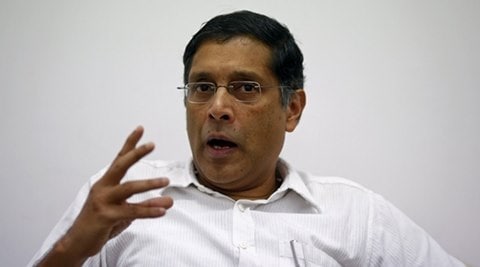Opinion On the move
Economic Survey takes a wide angle view of the challenges in a country in the midst of rapid change.
 Arvind Subramanian, chief economic adviser at India's Finance Ministry, speaks during an interview with Reuters in New Delhi, India, September 23, 2015. India does not need further fiscal stimulus to revive the economy, despite GDP growth seen at the lower end of an 8.1 percent to 8.5 percent target in the current financial year, Subramanian said on Wednesday. To match Interview INDIA-ECONOMY/ REUTERS/Adnan Abidi
Arvind Subramanian, chief economic adviser at India's Finance Ministry, speaks during an interview with Reuters in New Delhi, India, September 23, 2015. India does not need further fiscal stimulus to revive the economy, despite GDP growth seen at the lower end of an 8.1 percent to 8.5 percent target in the current financial year, Subramanian said on Wednesday. To match Interview INDIA-ECONOMY/ REUTERS/Adnan Abidi The most engaging part of the Economic Survey, authored by the finance ministry’s economic division led by its Chief Economic Advisor Arvind Subramanian, is in its small revelations: Based on rail passenger traffic, it pegs migration within India at 9 million a year, much higher than previous estimates, showing that the country is on the move. Through maps of built-up areas of cities, it shows how Bengaluru and Jaipur collect just 5-20 per cent of property taxes. Or how, contrary to perception, India trades more than China.
Watch What Else Is Making News
The Survey doesn’t stop at such findings. For instance, on migration, especially for women, who are migrating at a higher clip then men, it recommends policy responses that make food security, healthcare and other benefits portable between states. This sounds simple, but it requires enormous coordination between states, and asks of them not just to cooperate, but also to compete to retain the young workforce. Subramanian has used the Survey platform to make his first observations on the impact of demonetisation, one of the government’s two big challenges — the other being GST — and their impact on economic outlook. He sounds optimistic in limiting the adverse impact of demonetisation to just 0.5 percentage points of GDP. The Survey, he says, is not the forum to answer the question on broader aspects of management, as reflected in the design and implementation of the initiative. In an interview to this newspaper, he refused to spell out his verdict on whether the benefits outweigh costs. With more candour, Subramanian admits that job creation is a problem, and ties it to a revival of private sector investment. He admits the government has been unable to find a solution to the issue of rising non-performing assets of banks. Clearly, this government has failed to see it as an economic problem requiring a political decision.
The Survey points to successive governments’ hesitancy to embrace the private sector and to unambiguously protect property rights as a deep challenge. Added to this, lack of state capacity and extensive but inefficient redistribution has held back India from achieving closer to double digit growth targets. Overall, as it flags an array of evocative facts and challenges that reflect a changing India, instead of merely stating the obvious about the year past, the Survey indeed passes what Subramanian wryly called the “Amitabh Bachchan test” of tragedy, drama, comedy and romance.





